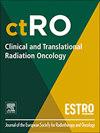Maximum disease diameter is associated with outcomes in stage II follicular lymphoma treated with radiation therapy alone
IF 2.7
3区 医学
Q3 ONCOLOGY
引用次数: 0
Abstract
Purpose
The optimal management of stage II follicular lymphoma (FL) is unclear. Radiation therapy (RT) alone has been the gold standard treatment, but a proportion of patients relapse. We sought to characterize outcomes and prognostic factors for stage II FL treated with RT alone to identify a high-risk subgroup of patients who may benefit from treatment intensification.
Methods
This was a population-based, province-wide, retrospective study. Included patients had grade 1–3A, non-mesenteric, stage IIA or IIAE FL diagnosed between 1986 and 2016 and treated with curative-intent (≥20 Gy) RT alone.
Results
102 patients were included. Median follow-up was 10.4 years (range, 0.3–22.3). Median age was 59 years (range, 33–86). Median greatest disease diameter was 3.6 cm (range, 1.5–11.5). Freedom from progression (FFP) was 60.3% at 5 years and 40.7% at 10 years. Overall survival (OS) was 89.2% at 5 years and 81.8% at 10 years. Greatest disease diameter of >3.6 cm was associated with inferior FFP (10-year FFP 34% vs. 47%, p = 0.013) on univariable analysis and inferior FFP (hazard ratio [HR] 1.87, p = 0.019) and inferior OS (HR 2.12, p = 0.027) on multivariable analysis (MVA). Older age was associated with inferior OS (HR 1.08, unit = 1 year, p < 0.001) on MVA.
Conclusions
40.7% of stage II FL patients treated with RT alone remained disease-free at 10 years. Greatest disease diameter >3.6 cm was associated with inferior FFP and OS, representing a novel prognostic indicator in this population that may help in the decision-making process on whether to complement RT with systemic therapy.
最大疾病直径与单纯放射治疗 II 期滤泡性淋巴瘤的疗效有关
目的 滤泡性淋巴瘤(FL)II期的最佳治疗方法尚不明确。单纯放射治疗(RT)一直是金标准治疗方法,但有一部分患者会复发。我们试图描述单纯 RT 治疗 II 期滤泡性淋巴瘤的疗效和预后因素,以确定可能从强化治疗中获益的高风险亚组患者。纳入的患者均为1986年至2016年间确诊的1-3A级、非肠系膜、IIA或IIAE期FL,并接受了单纯治愈性(≥20 Gy)RT治疗。中位随访时间为10.4年(0.3-22.3年)。中位年龄为 59 岁(33-86 岁)。疾病最大直径中位数为3.6厘米(范围为1.5-11.5)。5年无进展率(FFP)为60.3%,10年为40.7%。5年总生存率(OS)为89.2%,10年总生存率为81.8%。在单变量分析中,最大疾病直径为3.6厘米与较差的FFP相关(10年FFP为34%对47%,P = 0.013),在多变量分析(MVA)中与较差的FFP(危险比[HR] 1.87,P = 0.019)和较差的OS(HR 2.12,P = 0.027)相关。结论40.7%的单纯 RT 治疗 II 期 FL 患者在 10 年后仍无疾病。最大疾病直径3.6厘米与FFP和OS较差有关,这是该人群的一个新的预后指标,有助于决定是否在RT基础上进行全身治疗。
本文章由计算机程序翻译,如有差异,请以英文原文为准。
求助全文
约1分钟内获得全文
求助全文
来源期刊

Clinical and Translational Radiation Oncology
Medicine-Radiology, Nuclear Medicine and Imaging
CiteScore
5.30
自引率
3.20%
发文量
114
审稿时长
40 days
 求助内容:
求助内容: 应助结果提醒方式:
应助结果提醒方式:


